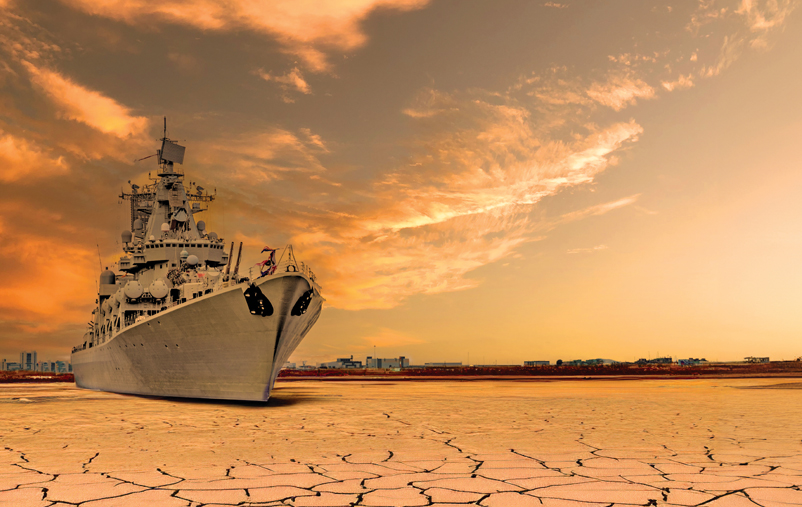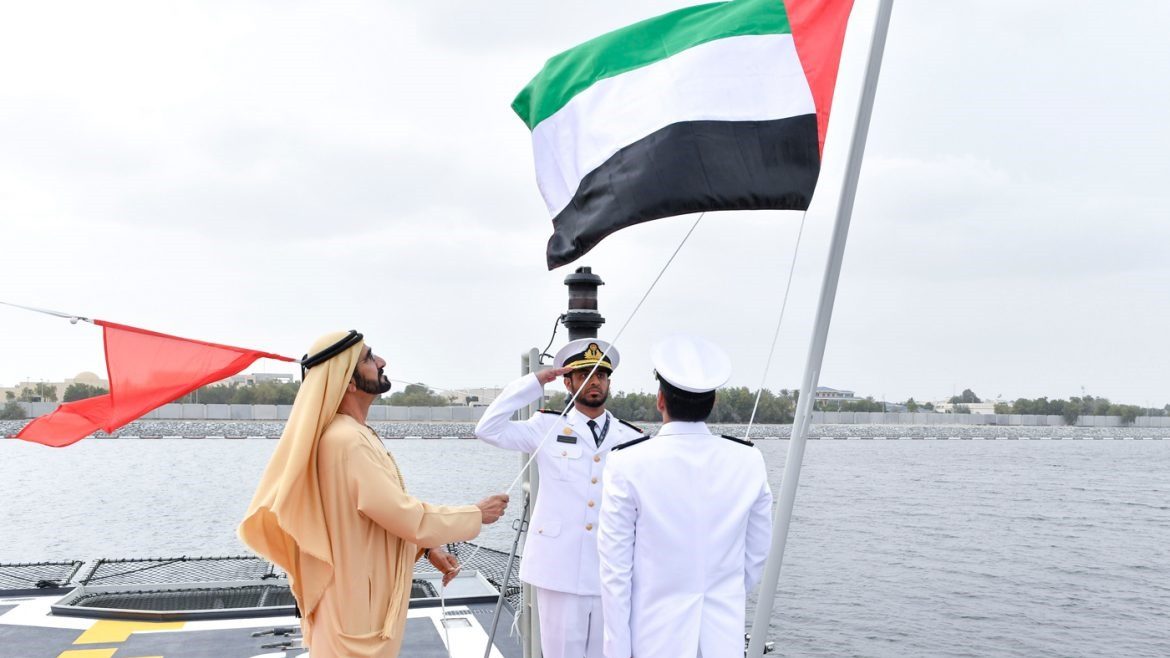In recent years, sustainability has emerged as a pivotal concept, embodying the balance between meeting present needs while safeguarding the capacity of future generations to fulfil their own. It has become a cornerstone in the pursuit of equilibrium across the social, economic, and environmental facets of development initiatives and strategies.
For naval forces, sustainability refers to the ability to sustain and endure over the long term by providing an optimal balance between the effectiveness and efficiency of the naval operations, preserving resources, improving energy efficiency, reducing environmental impact, and protecting marine environments simultaneously.
This necessitates naval units to operate sustainably by embracing principles, procedures, and technologies aimed at preserving oceans, mitigating the adverse impacts of maritime activities, and bolstering maritime security alongside naval capabilities. Sustainability is paramount in naval forces, primarily due to the demanding maritime working conditions and their profound impact on the marine environment. In recent years, there has been a notable shift towards prioritising sustainability techniques within naval operations, marking a significant area for research and development in the military sector. Implementing these sustainability techniques upholds the delicate balance of the marine ecosystem while simultaneously reducing the adverse effects of military activities on the sea and its inhabitants. Furthermore, sustainability in naval forces transcends a mere operational necessity; it is a strategic imperative aimed at safeguarding critical marine resources and averting their depletion. This necessitates the adoption of sustainable practices within this pivotal sector, not only to mitigate environmental impacts but also to attain economic and social sustainability in the long run.

Importance of Sustainability in Naval Forces:
The importance of sustainability in naval forces cannot be overstated, especially in light of the growing global concern over climate change and the imperative to reduce carbon emissions while safeguarding precious resources. Thus, examining and assessing sustainability practices within naval operations is crucial to evaluating their impact on the marine environment and the benefits they bring. This endeavour aims to refine the maritime strategies of armed forces, mitigating their adverse environmental effects and striving towards environmental, economic, and social sustainability in military activities.
To achieve these objectives, the following steps must be taken:
• Achieving a comprehensive understanding of how naval activities impact the environment
• Identifying and implementing sustainable maritime technologies to minimise negative repercussions
• Achieving efficient waste management
• Harnessing renewable energy sources
• Enhancing fuel consumption efficiency
• Preserving biodiversity and marine resources
• Regulating sustainable fishing practices, and safeguarding critical marine like coral reefs
• Reducing both environmental and economic costs within the naval sector
• Raising awareness among naval personnel about the importance of sustainability and promoting environmentally responsible behaviour
• Collaborating with local communities to align efforts and achieve mutually sustainable goals, thereby preserving the integrity of this vital sector
While the commercial maritime sector strides forward in adopting alternative fuels and cutting-edge technologies to enhance efficiency and reduce its carbon footprint, naval forces have been slower to embrace such innovations. This discrepancy can be attributed, in part, to unique security and defence considerations inherent to naval operations. These include ensuring a secure and uninterrupted fuel supply chain across global operations, maintaining interoperability with allied naval forces, ensuring survivability in combat scenarios, accommodating diverse ship types, and fulfilling various operational roles.
Sustainability Requirements in Naval Forces:
Sustainability in naval forces encompasses a multifaceted approach that involves balancing operational requirements with environmental responsibility. This entails adopting innovative strategies and collaborating with other sectors to address various aspects, including:
1. Carbon Removal from Defence Emissions: Military activities contribute 50% of government carbon emissions, posing risks such as asset vulnerability and resource conflicts. While achieving complete net-zero defence emissions by 2050, presents challenges, it’s feasible with strategies like carbon removal, emission reduction, and adopting low-carbon technologies such as sustainable aviation fuels and electric vehicles.
2. Operational Sustainability: Operational sustainability in the military context refers to maintaining necessary levels of activity to achieve objectives while preserving resources and environmental integrity. These technologies enhance the environmental, economic and social sustainability of naval forces and contribute to preserving the sea, marine resources, and providing security and environmental stability for the future.
3. Military Advancement towards Sustainability: Military effectiveness can be improved by conserving natural resources like water, land, and fuel, benefiting the environment and operational performance. Initiatives include educating personnel on energy efficiency, optimizing operations, and fostering innovation in sustainable technologies.
4. Policies and Military Force Sustainability: Developing holistic policies encompassing financial, social, and economic perspectives is essential to address crises, prevent conflicts, and foster peace while maintaining military readiness. This approach aims to build sustainable communities while ensuring security preparedness.
5. Energy and Sustainability Programs in Armies: Energy and sustainability programs align with military priorities of readiness, modernization, and partnership-building. These programs focus on enhancing energy efficiency, reducing environmental impact, and promoting sustainable practices throughout military operations.

Sustainability in the US Navy:
The US Navy and Marine Corps have unveiled their Climate Action 2030 strategy, in line with the state’s commitment to achieving net zero emissions by 2050.
This strategy outlines efforts within both branches of the US military to identify initiatives towards this goal while maintaining their capabilities for combat and victory worldwide.
US Secretary of the Navy, Carlos Del Toro, underscored the significance of climate change as a destabilizing force, emphasizing its impact on national security readiness, stating: “Climate change is one of the most destabilizing forces of our time, exacerbating other national security concerns and posing serious challenges to preparedness. Our maritime and amphibious forces are in the crosshairs of the climate crisis and this strategy provides a framework to enable us to significantly reduce the threat of climate change”.
Transboundary threats intensified by climate change necessitate adaptation within naval and marine forces to meet evolving operational demands, address humanitarian missions, enhance regional stability, and safeguard defence facilities and institutions.
For her part, Assistant Secretary of the Navy for Energy, Installations, and Environment, Meredith Berger, highlighted the imperative for the Navy to build resilience and reduce threats amidst climate change, stating: “Climate change increases risks, exposing vulnerabilities to our citizens, facilities, platforms, operations, allies, and partners. To remain dominant in the world, the Navy must adapt to climate change: building resilience and reducing threats.”
The Climate Action 2030 strategy for the Navy is based on decades of climate action across the Navy and Marine Corps, positioning the Navy on track to achieve national and global goals for climate change mitigation, with goals including reducing emissions, decreasing energy demand while increasing carbon-free electricity at naval facilities, and equipping naval forces with appropriate training, plans, and equipment to operate in a more volatile climate.
Moreover, the Navy is committed to capturing an additional five million metric tons of carbon dioxide or its equivalent of pollution annually by 2027. It will also deploy secure mini-grids or similar technology for carbon-free energy use in naval bases and facilities to support critical missions.
Building on this strategy, the US Navy has been at the forefront of climate change for years, managing assets worth tens of billions of dollars on every continent and in every ocean.
The Navy’s infrastructure requirements are defined by the tasks required of it. This requires understanding the types of tasks that the Navy may need to undertake in the coming years and the assets and infrastructure it will need to execute these tasks.
The US Navy has a clear vision of the challenges posed by climate change, and its leaders recognise that the effects of global warming will broaden the geographic scope of its mission and increase demand for its military and humanitarian services. Climate change will also reduce its ability to provide those services, with an increased risk of damage to its bases and ports.
Research suggests that responding to climate change requires two approaches: mitigation and adaptation. Mitigation refers to actions that reduce the amount of greenhouse gas emissions causing climate change and includes key examples such as replacing technologies with more energy-efficient ones and transitioning to renewable fuels. Moreover, mitigation efforts may require significant investments by the Navy, companies, or organizations, but the benefits of reducing the potential economic and social damages associated with climate change are significant in the long run.
Adaptation refers to measures that make the organization or naval force more resilient in facing continuous and expected changes in Earth systems. Common examples of this include shifting water-intensive operations from increasingly drought-prone areas, engineering buildings and sites in ways that enable them to avoid, withstand, or recover from floods and extreme weather events, adapting to natural disasters, particularly those resulting from advancing climate change, such as engaging in wars and managing border conflicts and dealing with refugees.

Sustainability in the Royal Navy:
The Royal Navy has long recognised the importance of cultural development in combating climate change, evident by its efforts to embed sustainability in all naval components, reduce emissions in its operations, and transition to a future fleet characterized by net zero carbon emissions.
While the Navy faces its own challenges, it is not alone. In modern militaries, there is increasing recognition that climate change will alter global security and work environments, additionally, there is more expectation that armed forces will play a role in mitigating its impact.
In a similar timeframe to the establishment of the Pentagon’s “Climate Change Working Group”, the UK Ministry of Defence published the document “Climate Change and the Strategic Approach to Sustainability” on March 30, 2021, outlining the British Army’s response to climate change challenges until 2050.
Lieutenant Richard Nugee wrote in the report’s introduction, “The escalation of modern global threats due to rising sea levels, harsh weather, and creeping desertification will undoubtedly lead to further conflict, requiring coordinated efforts in light of the government’s legal commitment to achieving net zero carbon emissions by 2050.”
Moreover, in April 2021, the UK became the first major economy to enshrine in law its goal of reducing greenhouse gas emissions to net zero by 2050. With the Ministry of Defence contributing approximately two million tons or 0.5% of the total greenhouse gas emissions in the UK.
Like the British Army, the Royal Navy is preparing to operate in a climate-affected world, where rising sea levels due to melting ice caps and new transit routes create new security risks. Admiral Sir Tony Radakin, Chief of the Defence Staff, described climate change as “a challenge we need to play our part in addressing through greener ships, more energy-efficient buildings, as well as better facilities.”
Clearly, urgent action must be taken to assess naval platforms and operations and understand where and how to achieve better optimisation ensuring broader net zero goals in the UK.
To this end, the UK Ministry of Defence recently published its strategic approach to sustainability and climate change, identifying three stages to ensure its ability to achieve the 2050 goals.
These stages include addressing already planned projects, reducing emissions using current and emerging technologies while building resilience in supply chains and real estate, and harnessing new technologies to build resilience and reduce emissions.
However, this approach was unclear on how this carbon reduction would be enacted in the practical exercise of the Royal Navy’s legacy and new ships, a problem encountered by many of the world’s leading naval forces, if not all.
On the other hand, most people accept that the goal of naval forces may not be to achieve net zero, but rather reduce emissions as much as possible. Encouragingly, the Navy has adopted a pragmatic approach, establishing several departments and administrations addressing climate to mitigate its environmental impact and embark on a campaign towards carbon removal.
While climate change encompasses everything, the key issues facing the Navy can be catagorised as follows: Fleet operations and making the fleet and naval bases more eco-friendly.
Speaking at the Net Zero Warship Engineering and Technology Conference in the UK in 2022, Vice Admiral Paul Bennett, Chief of Naval Staff, said, “Net Zero is a space we must be more ambitious in. Fortunately, the Navy seems in an advantageous position internationally with plans that may provide an opportunity to influence global allies as they transition to greener fleets.”
This conference marks an important event to showcase progress in sustainability areas in the Navy. In 2020, under pressure from International Maritime Organization regulations, the Navy had already been forced to change fuel types and transition to ultra-low sulfur fuel oil, resulting in a 77% global reduction in sulfur oxide emissions, or nearly 8.5 million metric tons annually.
» By: Retired Colonel Eng. Khaled Al-Ananzah
(Advisor and Trainer in Environmental and Occupational Safety)




















